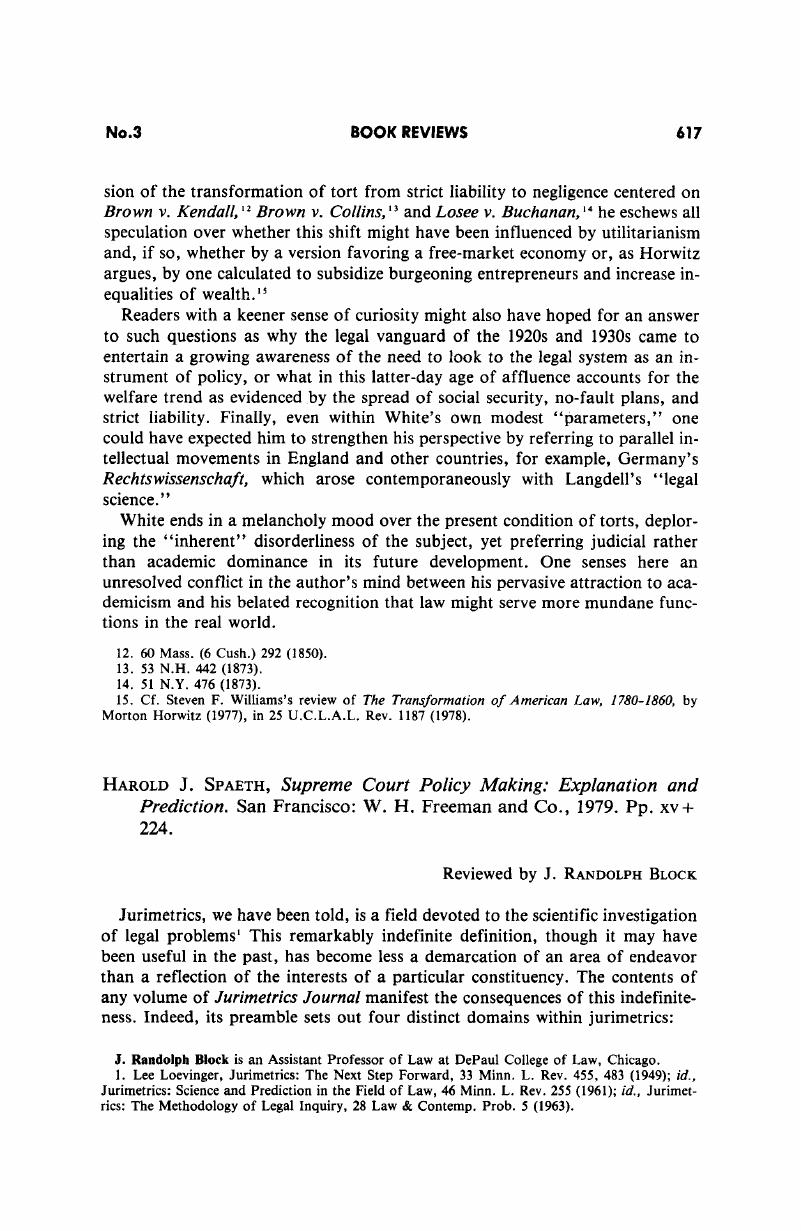No CrossRef data available.
Article contents
Harold J. Spaeth, Supreme Court Policy Making: Explanation and Prediction. San Francisco: W. H. Freeman and Co., 1979. Pp. xv+224.
Published online by Cambridge University Press: 27 December 2018
Abstract

- Type
- Book Reviews
- Information
- Copyright
- Copyright © American Bar Foundation, 1980
References
1. Loevinger, Lee, Jurimetrics: The Next Step Forward, 33 Minn. L. Rev. 455, 483 (1949); id., Jurimetrics: Science and Prediction in the Field of Law, 46 Minn. L. Rev. 255 (1961); id., Jurimetrics: The Methodology of Legal Inquiry, 28 Law & Contemp. Prob. 5 (1963).Google Scholar
2. Samuelson, Koopmans, & Stone, Report of the Evaluative Committee for Econometrica, 22 Econometrica 141 (1954).Google Scholar
3. Tanenhaus, Joseph, The Cumulative Scaling of Judicial Decisions, 79 Harv. L. Rev. 1583 (1966); Walter F. Murphy & Joseph Tanenhaus, The Study of Public Law 126–40 (New York: Random House, 1972).Google Scholar
4. David W. Rohde & Harold J. Spaeth, Supreme Court Decision Making (San Francisco: W. H. Freeman and Co., 1976).Google Scholar
5. Spaeth further separates each scale into attitude toward objects and attitude toward situation. Since I fail to see how this division contributes significantly to either the merits or the defects of his model, I will not attempt to criticize this particular innovation.Google Scholar
6. Note that the problem of manipulation of data becomes more acute in the instance of cases presenting more than one issue.Google Scholar
7. As quoted in Harold J. Spaeth, Unidimensionality and Item Invariance in Judicial Scaling, 10 Behavioral Sci. 290, 300 (1965).Google Scholar
8. Murphy & Tanenhaus, supra note 3, at 138.Google Scholar
9. Another jurimetrician, Glendon Schubert, has made a point of publishing his own cumulatively scaled decisions for just this purpose.Google Scholar
10. Spaeth, Harold J., Warren Court Attitudes Toward Business: The “B” Scale, in Glendon Schubert, ed., Judicial Decision-Making 79 (New York: Free Press of Glencoe, 1963).Google Scholar
11. Tanenhaus, supra note 3, at 1591–92.Google Scholar
12. Id. at 1592–94.Google Scholar
13. Murphy & Tanenhaus, supra note 3, at 139.Google Scholar
14. 407 U.S. 258 (1972).Google Scholar
15. Federal Baseball Club v. National League, 259 U.S. 200 (1922).Google Scholar
16. Toolson v. New York Yankees, 346 U.S. 356 (1953).Google Scholar
17. The best solution may be to have someone other than the researcher categorize the decisions according to some sort of content analysis to approximate “double-blind” laboratory conditions. See, e.g., Glendon Schubert, Jackson's Judicial Philosophy: An Exploration in Value Analysis, 59 Am. Political Sci. Rev. 940 (1965).CrossRefGoogle Scholar
18. Murphy and Tanenhaus have suggested another way to validate a scaling of decisions.Google Scholar
For example, he could begin by drawing a sample from the universe of relevant cases, such as those concerned with civil liberties, and seek to scale the votes contained in the sample. If his efforts to scale the sample cases met conventional criteria, he could then articulate the characteristics that presumably render the cases in the sample ordinal. Next the analyst could classify the remaining cases in the civil liberties universe in accordance with the characteristics identified. Finally, these cases could be randomly assigned to subsets and the cases in each subset arranged in the order taken in the original scalogram by cases with comparable characteristics. If the matrix for each of the subsets were to yield sufficiently high CRs and Ss, confidence in the validity of the original scale would be substantially enhanced. Such procedures are laborious, but validity, like chastity, is a demanding virtue.
Murphy & Tanenhaus, supra note 3, at 139.Google Scholar
19. Christ, Carl F., Econometric Models and Methods 4, 5 (New York: John Wiley & Sons, Inc., 1966).Google Scholar
20. Jackson, Robert H., The Supreme Court in the American System of Government 76 (Cambridge, Mass.: Harvard University Press, 1955).Google Scholar
21. Bickel, Alexander M., The Least Dangerous Branch: The Supreme Court at the Bar of Politics 79–81 (Indianapolis: Bobbs-Merrill Co., 1962).Google Scholar
22. Cambridge, Mass.: Harvard University Press, 1977.Google Scholar
23. London: Duckworth, 1977.Google Scholar
24. Cambridge, Mass.: Harvard University Press, 1980.Google Scholar
25. Jackson, supra note 20, at 77.CrossRefGoogle Scholar
26. 410 U.S. 113 (1973).Google Scholar




